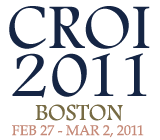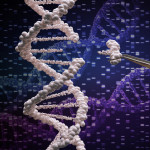 SB-728-T, a gene therapy designed to knock out the CCR5 receptor on CD4 cells, protects and increases CD4s in patients experiencing poor immunologic recovery while on antiretroviral (ARV) therapy, according to preliminary Phase I study data reported on Monday, February 28, at the 18th Conference on Retroviruses and Opportunistic Infections (CROI) in Boston. The new results, reported by Jay Lalezari, MD, are among the first from a human study illustrating the therapeutic—and curative—potential of this novel approach being developed by Sangamo BioSciences.
SB-728-T, a gene therapy designed to knock out the CCR5 receptor on CD4 cells, protects and increases CD4s in patients experiencing poor immunologic recovery while on antiretroviral (ARV) therapy, according to preliminary Phase I study data reported on Monday, February 28, at the 18th Conference on Retroviruses and Opportunistic Infections (CROI) in Boston. The new results, reported by Jay Lalezari, MD, are among the first from a human study illustrating the therapeutic—and curative—potential of this novel approach being developed by Sangamo BioSciences.
After HIV binds to the CD4 protein on T-cells, the virus must then latch onto another receptor on the cell’s surface – either CCR5 or CXCR4. Earlier in the course of HIV disease, most people have HIV that uses the CCR5 receptor. Later on, as HIV disease progresses, the virus can switch to the CXCR4 receptor—this occurs in approximately 50 percent of treatment-experienced patients.
Selzentry (maraviroc), a U.S. Food and Drug Administration (FDA)-approved ARV, works by blocking the interaction between CCR5 and HIV, ultimately retarding the virus’s ability to infect CD4 cells. SB-728-T, a zinc finger DNA-binding protein transcription factor, goes one step further—it blocks the gene responsible for making CCR5, mimicking a naturally occurring human mutation that renders individuals largely resistant to the virus.
This mutation, dubbed CCR5 delta-32, appears to have no deleterious effect in the human body. In addition, a study published in Blood in December 2010 reported an effective cure when an HIV-positive patient with leukemia received a bone marrow transplant from a “matched” donor with this delta-32 CCR5 mutation.
Sangamo is also developing a gene therapy designed to knock out CXCR4, as highlighted in a separate presentation at CROI by Craig Wilen, a biomedical graduate student at the University of Pennsylvania. For individuals with viruses that attach to CXCR4 instead of CCR5, SB-728-T is not likely to help; these people need a therapy that targets the gene responsible for creating CXCR4 receptors on CD4 cells. What is not yet clear, however, is whether a gene therapy that knocks out CXCR4—much less is known about this receptor and individuals lacking the gene responsible for producing this receptor have not been studied—is a safe avenue to explore.
 | |
| Jay Lalezari, MD, talks about his team’s SB-728-T study at CROI 2011 (click here). |
Therapy involves removing CD4 cells from patients’ blood, treating the cells with SB-728-T to knock out the CCR5 gene, multiplying the cells in the lab, then transplanting the HIV-resistant genetically modified cells back into the body.
Curing HIV will be a bit more complicated, as it ultimately requires replacing the entire CD4 population with HIV-resistant cells, not merely creating a small reservoir of protected cells. A curative approach will likely involve removing and treating stem cells with CCR5 and possibly CXCR4 knockout genes, administering high-dose chemotherapy to wipe out the existing HIV-susceptible immune system, followed by transplanting the modified stem cells to rebuild an immune system that is resistant to the virus.
Paula Cannon, PhD, of the University of Southern California will be reviewing her group’s success with CCR5-depleted stem cells in mice with humanized immune systems during a Wednesday afternoon, March 2, session at CROI.
Lalezari reported preliminary results from his group’s Phase I study (SB-728-0902) involving HIV-positive patients with “immune-discordant” responses to ARV therapy—undetectable viral loads but limited CD4 gains despite several years of treatment. Thus far, the study has treated six immune-discordant patients, most of whom had been living with HIV for at least 20 years and had CD4s hovering between 200 and 500 despite several years of ARV therapy.
Three patients received transplants of 10 billion CD4s and three received transplants of 20 billion CD4s. A third cohort, consisting of another three patients, will receive 30 billion CD4s. And a fourth cohort, made up of four HIV-positive individuals no longer responding virologically to ARV therapy, was recently added to the study.
Lalezari also reported that, after the treated cells were multiplied in the lab, approximately 26 percent of the cells transplanted back into the patient were successfully modified. In other words, approximately one quarter of the 10 billion and 20 billion cells infused after treatment and reproduction in the laboratory were likely resistant to HIV.
Thus far, transplantation has been well tolerated. No serious adverse events were reported after the gene-modified cells were infused. While there were several incidences of drug-related side effects—including chills, fever, headache, sweats, dizziness, fatigue and a short-lived “garlic” body odor (likely due to one of the compounds used to freeze the cells before transplanting)—all adverse events were easily managed. In addition, Lalezari’s group documented no laboratory abnormalities.
The modified cells were successfully engrafted in all patients and persisted in five subjects. Fourteen days after the transplant, SB-728-T-treated CD4 cells made up 1 percent to 6 percent of the cells in the blood of these five patients, appreciable numbers that remained consistent through at least 90 days in the study. These five patients also experienced significant increases in their CD4 cell counts—average gains of 200 CD4s were reported—in the weeks and months following their transplants. One patient, followed for nearly a year, has had a 300 CD4 cell count gain over his pre-treatment level.
The one study volunteer who didn’t have a robust response to therapy developed high levels of antibodies to the adenovirus vector—the virus used to expose the CD4 cells to the gene therapy in the lab.
In addition, five of the six subjects also exhibited sustained improvements in their CD4:CD8 cell ratio, an indicator of immunologic health that is infrequently documented in ARV therapy clinical trials.
The modified cells also took up residence in rectal tissue—a major reservoir of virus in the body—suggesting, as predicted, that the cells were proliferating and remaining impervious to HIV infection.
"These data represent the beginning of a new hope for HIV therapy," said Lalezari. "This approach aims to provide a protected reservoir of HIV-resistant CD4 cells that are available to fight infections, including the virus. I look forward to completing the follow-up of this initial study and to working with Sangamo as it expands these studies to include the full range of HIV-infected populations."






13 Comments
13 Comments